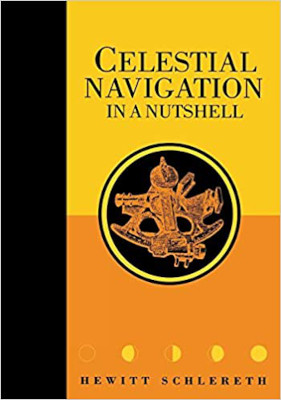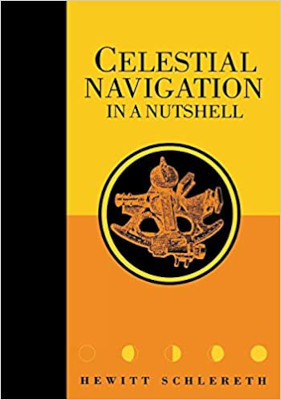
I was introduced to celestial navigation, in part, by Hewitt Schlereth’s earlier book Commonsense Celestial Navigation, now out of print. I was, therefore, eager but somewhat intimidated by the prospect of reviewing a new work by Schlereth. Unfortunately, this book is a disappointment.
The book opens with an excellent summary of what navigation is all about: “Navigation . . . has two steps: (1) Keeping the [dead reckoning position], and (2) Periodically checking it by other means. In reality, navigation is a process of the one checking the other.”
In short, the job is about making an educated assumption about the boat’s position and then checking the assumption with outside data. In the case of this book, that data comes from sextant work with the sun, moon, planets, and stars.
What follows is a lengthy (for a “nutshell book”) discussion of why celestial navigation works. The discussion brings in spherical trigonometry and presents specialized terms, for example, “great circle,” without defining them. The steps through sight reduction using printed pre-computed tables are direct, if somewhat clouded by theoretical discussions. The table entries in the examples are highlighted in the illustrations by careful use of screening over the tables. Unfortunately, the line illustrations are no more than workmanlike. This book deserves better artwork.
After reading about the importance of keeping the dead-reckoning track, I found the plotting-sheet examples of this critical task received far less discussion than how positions are determined. With a number of lines of position, or LOPs, on a sheet, clarity and organization are vital if the plotting sheet’s information is to be understood. Why Schlereth draws lines toward the sun’s geographic position (the spot on earth where the sun is directly overhead) escapes me. It’s enough to mark the LOP with the time of the shot that produced it and the appropriate symbol for the sun. The process of constructing the LOP is enough to reconstruct a line to the geographic position – something that is rarely needed anyway.
I’ve skipped over the particularly nice choice of using Venus as the introduction to shooting something other than the sun to get an LOP. The concluding discussion of accuracy in navigation is also well worth reading. As a whole, this is a book that tries hard to reach port but seems to be still at sea, foundering in complexities best left for extended discussions of celestial navigation.
Celestial Navigation in a Nutshell by Hewitt Schlereth (Sheridan House, 2000; 144 pages)





